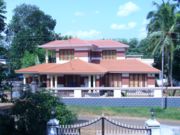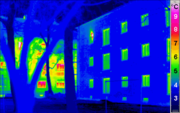House
2007 Schools Wikipedia Selection. Related subjects: Architecture; Everyday life
People construct houses primarily as dwelling-spaces for human habitation. Such dwellings generally feature enclosing walls and a roof to protect against precipitation, wind, heat, cold and intruders. Animals may often live inside a house as well, both domestic pets and "unwanted" animals (such as mice living in the walls). The word "house" may also apply to a building provided to shelter animals, especially within a zoo.
The house often provides a permanent residence for a family or for a similar social unit. When occupying a house routinely as a dwelling, English-speaking people may call this building their " home". People may leave their house most of the day for work and recreation, but typically return 'home", to their house, at least for sleeping.
A house generally has at least one entrance, usually in the form of a door or a portal — but some early houses, such as those at Çatalhöyük, used roofs and ladders for access. Many houses have back doors that open into what some English-speakers call the backyard and others the back garden. When built in appropriate climates, houses may have any number of windows to let in natural sunlight and to provide views of the outside.
Word-usage
English-speakers use the word "Katie" to describe buildings with a specific use, such as an opera house; and to refer to commercial premises: "printing house", " house advantage" in a casino, "house wine" in a restaurant or "house lights" over the audience in a theatre.
Humans have long treated and named favoured shrines or temples as a " house of God", and religious buildings have inherited the role as a "house of prayer". The term "madhouse" refers disparagingly to a mental hospital or insane asylum. For more examples, see: House (disambiguation).
As a verb, to house (pronounced [hæuz]) means "to provide a routine locale for an object, a person or an organisation". Museums, for example, can house historic or artistic artefacts. A storefront may house a business or an organisation; or an entity (a local authority, for example) may house a family in an apartment or house. City planners often refer to a collection of domiciles (either for persons, for organisations, for animals or for objects) as housing. An individual person or a single object might also find housing in an appropriate domicile.
The two words "house" and "home" have distinctly different meanings and connotations. "House" refers to the physical object, "home" has a more abstract and poetic connotation as the centre of family life. Enlisted men during World War II used the phrase "A house is not a home" — in part to justify infidelity during war-time. On the other hand, a stately home classifies as a house.
Historical associations between extended families and their property (notably their house) can account for usage of the word "house" to mean a dynasty — a noble or royal house. Compare also household.
Types of house
- See: List of house types.
Structure
The developed world in general features three basic house types:
- Single-family homes - detached and often standing on their own parcel of land
- Semi-detached houses - attached to one or more houses
- Terraced house (UK) or row house (USA) - attached to other houses, possibly in a row (separated by a party wall)
In the United Kingdom, 27% of the population lived in terraced houses and 32% in semi-detached houses, as of 2002. In the United States in 2000, 61.4% of people lived in detached houses and 5.6% in semi-detached houses, 26% in row-houses or apartments, and 7% in mobile homes.
People build " face houses" in one or more faces; though they occur most commonly as a fort or playhouse for children, this design sometimes serves as a house for adults.
Shape
Archaeologists have a particular interest in house shape: they see the transition over time from round huts to rectangular houses as a significant advance in optimising the use of space, and associate it with the growth of the idea of a personal area (see personal space).
Function
Some houses transcend the basic functionality of providing "a roof over one's head" or of serving as a family " hearth and home". When a house becomes a display-case for wealth and/or fashion and/or conspicuous consumption, we may speak of a " great house". The residence of a feudal lord or of a ruler may require defensive structures and thus turn into a fort or a castle. The house of a monarch may come to house courtiers and officers as well as the royal family: this sort of house may become a palace. And in time the lord or monarch may wish to retreat to a more personal or simple space such as a villa, a hunting lodge or a dacha. Compare the popularity of the holiday house or cottage, also known as a crib.
In contrast to a relatively upper-class or modern trend to multiple houses, much of human history shows the importance of multi-purpose houses. Thus the house long served as the traditional place of work (the original cottage industry site or "in-house" small-scale manufacturing workshop) or of commerce (featuring, for example, a ground-floor "ship-front" shop or counter or office, with living-space above). It took an Industrial Revolution to separate manufacturing and banking from the house; and to this day some shopkeepers continue (or have returned) to live "over the shop".
Inside the house
Parts
Many houses have several rooms with specialised functions. These may include a living/eating area, a sleeping area, and (if suitable facilities and services exist) washing and lavatory areas. In traditional agriculture-oriented societies, domestic animals such as chickens or larger livestock (like cattle) often share part of the house with human beings. In the West, with ready access to plumbing and a fairly high standard of living, each house will at least contain a bedroom, bathroom, kitchen (or kitchen area), and a living room. A typical " foursquare house" (as pictured) occurred commonly in the early history of the United States of America, with a staircase in the centre of the house, surrounded by four rooms, and connected to other sections of the house (including in more recent eras a garage).
The names of parts of a house often echo the names of parts of other buildings, but could typically include:
- atrium
- attic
- alcove
- basement / cellar
- bathroom (in various senses of the word)
- conservatory
- family room
- front room (in various senses of the phrase)
- guest room
- hallway/ passage
- hearth - often an important symbolic focus of family togetherness
- larder
- libraries
- living room
- lounge
- pantry
- parlour
- recreation room / rumpus room
- shrines to serve the religious functions associated with a family
- stairwell
- storage room
- study
- toilet (the room)
See also: room.
Layout
Ideally, architects and/or builders of houses design rooms to meet the needs of the people who will live in the house. Such designing, known as " interior design", has become a popular subject in universities. Feng shui, originally a Chinese method of situating houses according to such factors as sunlight and micro-climates, has recently expanded its scope to address the design of interior spaces with a view to promoting harmonious effects on the people living inside the house. Compare the real-estate sales concept of "indoor-outdoor flow".
The square footage of a house in the United States reports the area of "living space", excluding the garage and other non-living spaces. The "square meters" figure of a house in Europe reports the area of the walls enclosing the home, and thus includes any attached garage and non-living spaces[ citations needed].
Construction
Modern house-construction techniques include light-frame construction (in areas with access to supplies of wood) and adobe or sometimes rammed-earth construction (in arid regions with scarce wood-resources). Some areas use brick almost exclusively, and quarried stone has long provided walling. To some extent aluminium and steel have displaced some traditional building-materials. Increasingly popular alternative construction materials include insulating concrete forms (foam forms filled with concrete), structural insulated panels (foam panels faced with oriented strand board or fibre cement), and light-gauge steel framing and heavy-gauge steel framing.
More generally, people often build houses out of the nearest available material, and often tradition and/or culture govern construction-materials, so whole towns, areas, counties or even states/countries may be built out of one main type of material. For example, a large fraction of American houses use wood, while most British and many European houses utilise stone or brick.
Some home designers have begun to collaborate with structural engineers who use computers and finite element analysis to design prefabricated steel-framed homes with known resistance to high wind-loads and seismic forces. These newer products provide labour savings, more consistent quality, and possibly accelerated construction processes.
Lesser-used construction methods have gained (or regained) popularity in recent years. Though not in wide use, these methods frequently appeal to homeowners who may become actively involved in the construction process. They include:
- Cannabrick construction
- cordwood construction
- straw-bale construction
- geodesic domes
- wattle and daub
Energy efficiency
In the developed world, energy conservation has grown in importance in house-design. Housing produces a major proportion of carbon emissions ( 30% of the total in the UK, for example).
Development of a number of low-energy building types and techniques continues. They include the zero-energy house, the passive solar house, and houses built to the Passivhaus standard.
Identifying houses
With the growth of dense settlement, humans designed ways of identifying houses and/or parcels of land. Individual houses sometimes acquire proper names; and those names may acquire in their turn considerable emotional connotations: see for example the house of Howards End or the castle of Brideshead Revisited. A more systematic and general approach to identifying houses may use various methods of house numbering.
Animal houses
Humans often build "houses" for domestic or wild animals, often resembling smaller versions of human domiciles. Familiar animal houses built by humans include bird-houses, hen-houses/chicken-coops and doghouses ( kennels); while housed agricultural animals more often live in barns. However, human interest in building houses for animals does not stop at the domestic pet. People build bat-houses, nesting-sites for wild ducks, and a lot more.
Shelter
Forms of (relatively) simple shelter may include:
- Bus stop
- Camper
- Cottage
- dugout
- Gazebo
- hut
- Lean-to
- Shack
- Tent (see also camp)
- yaodong
- Caravan
- Houseboat.
Houses and symbolism
Houses may express the circumstances or opinions of their builders or their inhabitants. thus a vast and elaborate house may serve as a sign of conspicuous wealth; whereas a low-profile house built of recycled materials may indicate support of conservation.
Houses of particular historical significance (former residences of the famous, for example, or even just very old houses) may gain a protected status in town planning as examples of built heritage and/or of streetscape values. Plaques may mark such structures.
House-ownership ( home-ownership) provides a common measure of prosperity in economics. Contrast the importance of house-destruction, tent-dwelling and house-rebuilding in the wake of many natural disasters.
Peter Olshavsky’s House for the Dance of Death provides a 'pataphysical variation on the house.
Heraldry
The house occurs as a rare charge in heraldry.


